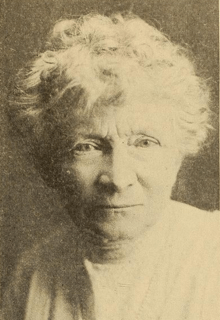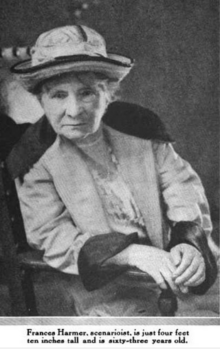Frances Harmer
Frances Harmer (1858 – January 1927) was an English-born writer of short stories and a screenwriter in Hollywood, known as the "Little Mother of the Movies".



Early life
Frances A. Harmer was born in England. She moved to the United States as a young woman,[1] and worked as a teacher.[2]
Writing
Harmer lived in New York City, and then in Los Angeles, California. She wrote under several pseudonyms.[2] Published short stories by Harmer included "The Cheat" (1907), "Losing to Win" (1908),[3] "Counting Love's Toll" (1908), "When Love is Lord", "A Newport Nobody",[1] "The Test", "The Wooing of Sheilah", "Hidden Gold" (1910), "The Helping Hand" (1913), "Both Fair and Good" (1913),[4] "The Lame Boy's Gift" (1914),[5] "The Transient" (1914),[6] "The Gift of Speech" (1914),[7] "The Painting of Perdita" (1915), "A Pair of Pink Shoes" (1915), "While His Mother Was Away" (1916),[8] "The Girl He Left Behind Him" (serialized, 1917),[9] "The Honorable Roy Carteret" (1917), "Managing Miriam" (1917), "The Portrait" (1917), "Peggy Steals a Week" (1917), "The Mentor and the Maid" (1918), and "The Backward Path" (1918).[10] A story by Harmer was the basis for the Bebe Daniels film One Wild Week (1921, now lost).[11]
Hollywood
Harmer was called "Little Mother of the Movies".[12] She worked at the Famous Players-Lasky studio as head of the reading department, evaluating scripts. Later she was "literary assistant" to William C. de Mille,[13] and adapted stories for the screen. She was described as "a little white-haired old lady, simply dressed in gray" in 1921.[14] She described the challenges of reading scripts in the silent era in a 1922 essay: "Too few writers, whose laurels are yet to be won, are able to visualize – to look at a blank wall and see thereon the figures of their characters in Moving Action."[15] Elsewhere, she also discussed the problem of hopeful screenwriters attaching their names to existing well-known theatrical scripts, saying "People seem to think we moving picture people have never read, seen, nor heard anything."[16]
In 1922 she wrote an open letter in the aftermath of William Desmond Taylor's murder, insisting that "Hollywood is not a hotbed of iniquity or a 'Sodom and Gomorrah,' nor at all worse than any other city."[17]
Personal life
Frances Harmer retired in 1924, and died in 1927, aged 68 years (though her age was frequently exaggerated in newspapers), in New York City.[2][12]
References
- "Writers of the Day" The Writer (November 1919): 170-171.
- Alma Whitaker, "Sugar and Spice" Los Angeles Times (November 8, 1925): 28. via Newspapers.com

- Frances Harmer, "Losing to Win" The New Broadway Magazine (June 1908): 383.
- Frances Harmer, "Both Fair and Good" Hearst's Magazine (September 1913): 337-343.
- Frances Harmer, "The Lame Boy's Gift" Christian Register (January 1, 1914): 16.
- Frances Harmer, "The Transient" Christian Register (April 2, 1914): 328.
- Frances Harmer, "The Gift of Speech" Christian Register (April 23, 1914): 400.
- Frances Harmer, "While His Mother was Away" Ottumwa Tri-Weekly Courier (April 22, 1916): 6. via Newspapers.com

- Frances Harmer, "The Girl He Left Behind Him" Farm Journal (October 1917): 539.
- Frances Harmer in The General Fiction Magazine Index.
- Kenneth White Munden, ed.,The American Film Institute Catalog of Motion Pictures Produced in the United States, Part 1 (University of California Press 1997): 572. ISBN 9780520209695
- "Frances Harmer, 'Little Mother of the Movies', Dies" Los Angeles Times (January 5, 1927): 16. via Newspapers.com

- "After the Show" Greensboro Daily News (November 11, 1921): 3. via Newspapers.com

- "A White-Haired 'Child of Promise'" Photoplay (October 1921): 25.
- Frances Harmer, "Common Faults in Continuity Writing" The Photodramatist (May 1922): 11-12.
- "H. H. Van Loan's Own Corner" The Photodramatist (December 1922): 31.
- "Defends Films and Hollywood" Hollywood Citizen (February 17, 1922).